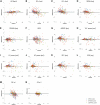Smartwatch-derived heart rate variability: a head-to-head comparison with the gold standard in cardiovascular disease
- PMID: 37265873
- PMCID: PMC10232241
- DOI: 10.1093/ehjdh/ztad022
Smartwatch-derived heart rate variability: a head-to-head comparison with the gold standard in cardiovascular disease
Abstract
Aims: We aimed to investigate the concordance between heart rate variability (HRV) derived from the photoplethysmographic (PPG) signal of a commercially available smartwatch compared with the gold-standard high-resolution electrocardiogram (ECG)-derived HRV in patients with cardiovascular disease.
Methods and results: We prospectively enrolled 104 survivors of acute ST-elevation myocardial infarction, 129 patients after an ischaemic stroke, and 30 controls. All subjects underwent simultaneous recording of a smartwatch (Garmin vivoactive 4; Garmin Ltd, Olathe, KS, USA)-derived PPG signal and a high-resolution (1000 Hz) ECG for 30 min under standardized conditions. HRV measures in time and frequency domain, non-linear measures, as well as deceleration capacity (DC) were calculated according to previously published technologies from both signals. Lin's concordance correlation coefficient (ρc) between smartwatch-derived and ECG-based HRV markers was used as a measure of diagnostic accuracy. A very high concordance within the whole study cohort was observed for the mean heart rate (ρc = 0.9998), standard deviation of the averages of normal-to-normal (NN) intervals in all 5min segments (SDANN; ρc = 0.9617), and very low frequency power (VLF power; ρc = 0.9613). In contrast, detrended fluctuation analysis (DF-α1; ρc = 0.5919) and the square mean root of the sum of squares of adjacent NN-interval differences (rMSSD; ρc = 0.6617) showed only moderate concordance.
Conclusion: Smartwatch-derived HRV provides a practical alternative with excellent accuracy compared with ECG-based HRV for global markers and those characterizing lower frequency components. However, caution is warranted with HRV markers that predominantly assess short-term variability.
Keywords: Deceleration capacity; Heart rate variability; Smartwatch; Wearables.
© The Author(s) 2023. Published by Oxford University Press on behalf of the European Society of Cardiology.
Conflict of interest statement
Conflict of interest: None declared.
Figures





References
-
- Task Force of the ESC . Heart rate variability standards of measurement, physiological interpretation, and clinical use. Circulation 1996;93:1043–1065. - PubMed
-
- Corr P, Yamada K, Witkowski F, Fozzard H, Haber E, Jennings R, et al. Mechanisms Controlling Cardiac Autonomic Function and Their Relation to Arrhythmogenesis. New York: Raven Press; 1986.
-
- Lown B, Verrier RL. Neural activity and ventricular fibrillation. N Engl J Med 1976;294:1165–1170. - PubMed
-
- Kleiger RE, Miller JP, Bigger JT, Moss AJ. Decreased heart rate variability and its association with increased mortality after acute myocardial infarction. Am J Cardiol 1987;59:256–262. - PubMed
-
- Adamson PB, Smith AL, Abraham WT, Kleckner KJ, Stadler RW, Shih A, et al. Continuous autonomic assessment in patients with symptomatic heart failure: prognostic value of heart rate variability measured by an implanted cardiac resynchronization device. Circulation 2004;110:2389–2394. - PubMed
Grants and funding
LinkOut - more resources
Full Text Sources
Miscellaneous
